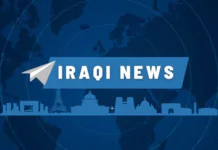The Central Bank Develops The Structure Of External Financial Transfers: A Decisive Step Against Manipulation And Smuggling.
Reports Economy News – Baghdad In a new effort to limit the smuggling of foreign currency and regulate foreign trade, the Central Bank of Iraq has taken a decisive step by issuing binding instructions to regulate the mechanism for dealing with commercial invoices in all authorized banks, in coordination with the Ministry of Finance and the General Authority of Customs, within the framework of implementing Cabinet Resolution No. (569) of 2025.
These measures are part of the national project to automate and modernize customs.
They aim to enhance transparency and oversight of foreign money transfers,at a time when Iraq is facing increasing challenges in controlling the flow of funds and intensifying regulatory measures to curb fraud and smuggling.
As of Wednesday, January 1, 2025, the Central Bank of Iraq suspended the electronic platform used to sell dollars to banks and companies at the official exchange rate of 1,320 dinars per dollar.
Deputy Governor of the Central Bank, Ammar Khalaf, told reporters that the electronic dollar platform has been suspended, but that foreign trade financing continues through banks, according to mechanisms that parallel those in place worldwide.
In a related statement, the Central Bank of Iraq previously explained that this transition went through several stages in the foreign exchange process, beginning with the foreign currency buying and selling window, moving on to the electronic platform for foreign transfers, and concluding with gradual balance enhancements throughout 2024, with full implementation occurring in the final week of that year.
The Central Bank of Iraq recently issued a new circular to all authorized banks, which included detailed instructions regarding commercial invoices whose values are required to be transferred abroad, based on the directives of the Ministry of Finance and the General Authority of Customs, and within the framework of facilitating the implementation of Cabinet Resolution No. (569) of 2025.
According to the circular, it was decided that the commercial invoice must include a set of basic information, most notably: invoice number and date, payment and shipping terms, currency and value, the Harmonized System of Customs (HS Code), which must not be less than six digits, in addition to data on the exporter and importer, and a precise description of the goods, their origin, brand, quantity, unit of measurement, unit price, and total price.
The circular also indicated the adoption of one of two types of invoices: either the final commercial invoice, or the preliminary invoice attached to the sales contract, provided that the final invoice contains all the information included in the preliminary invoice.
The Central Bank confirmed that these instructions will be officially adopted for financial transfers and customs clearance operations starting November 1, 2025.
Meanwhile, the Prime Minister’s Advisor for Financial and Economic Affairs, Mazhar Mohammed Salih, said that the new measures announced by the Central Bank of Iraq to prevent dollar smuggling, which will be implemented starting next month, “appear to be good for now.”
“We can wait for its effectiveness, but it looks good for now,” Saleh added to Al-Eqtisad News, indicating that the results of these measures can be evaluated after their actual implementation.
For its part, the Echo Iraq Observatory commented on the new instructions issued by the Central Bank of Iraq regarding the regulation of commercial invoices for financial transfers and customs clearance, considering them an important step toward enhancing transparency and controlling financial procedures.
The Observatory said that Circular No. (267/4/9) dated October 15, 2025, directed authorized banks to include in commercial invoices basic information related to payment and shipping terms, value and invoice currency, and the Global Harmonized System of Customs (GHS) code, in addition to the addresses of the importer and exporter, a description of the goods, their origin and trademark, in addition to the quantity, unit price and total price.
Echo Iraq explained that the Central Bank stipulated the adoption of one of two types of invoices: either the final commercial invoice or the preliminary invoice attached to the sales contract, provided that the final invoice contains all the information of the preliminary invoice.
The Observatory confirmed that these instructions will be implemented starting November 1, 2025, noting that the decision falls within the framework of the National Automation Project, which seeks to regulate foreign transfers more precisely and reduce loopholes that could be exploited for manipulation or evasion.
Echo Iraq considered the new instructions a positive step toward unifying banking and customs procedures, contributing to reducing errors and improving oversight of commercial transactions, thus supporting the Customs Modernization and Financial Governance Project in Iraq. https://economy-news.net/content.php?id=61442
Monetary Policy And Financial Stability In The Archives Of The Writings Of The Governor Of The Central Bank Of Iraq
Samir Al-Nusairi The Central Bank of Iraq, since its establishment in 1947 and until 2025, has gone through phases of phenomena, challenges and achievements.
These 78 years have witnessed major transformations in objectives, tools, functions and mechanisms, particularly the shift of monetary policy from a traditional policy to an unconventional policy aimed at stimulating the economy and moving it rapidly towards economic growth, enhancing financial stability in accordance with new international standard criteria, regulating the global financial system, achieving a digital transformation methodology and moving from a monetary economy to a digital economy.
What distinguished the Central Bank’s journey were the fundamental pillars and foundations that were built during the years (2015-2020) and the implementation of these pillars bore fruit in the years (2023-2025) through the implementation of new policies, initiatives and programs adopted by the Central Bank.
The important thing here is to read the past, analyze it and build on it in drawing a picture of the future.
This is achieved when there are real economic leaders who examine reality and sense the future with insightful eyes that look with great hope to building a strong and solid national economy based on clear foundations to achieve comprehensive and radical reform and a solid, modern, comprehensive and flexible banking sector, while revolutionizing the basic productive sectors such as agriculture and industry, diversifying sources of national income other than oil and moving from rentierism to productivity.
In light of my review of the archive of what was written about the Central Bank, I found that the most prominent thing in the archive is what was written by the Governor of the Central Bank, Dr. Ali Mohsen Al-Alaq, in his books entitled (Writings on Monetary Policy and Financial Stability), published in 2021, and the book(Managing the Central Bank from the Margins of the Past to the Body of the Future), published in 2022.
In the first book, in 10 chapters, he explained the role of the Central Bank in facing the economic and security challenges and shocks in (2015-2016), presented the challenges of the general budget, and reviewed the structure and presentation of the budget within the framework of the macroeconomy and the stability of public finances (2017-2021), and reduced the exchange rate of the Iraqi dinar, its determinants and alternatives, and concluded with the components of the desired economic development.
The second book discusses, in a scientific, realistic, and analytical manner, a significant phase of the challenges faced by the Central Bank of Iraq during the most dire circumstances Iraq has ever faced.
The Central Bank shouldered the burden of confronting the crises facing our national economy and bridging the deficit in the general budget by re-discounting treasury transfers issued by the government, which had a significant impact on the decline in foreign exchange reserves to 43 billion dinars in 2016.
The book includes nine chapters that address strategic planning and change management.
The emerging objectives of central banks include the shift from rules-based to risk-based oversight, the transition from combating inflation to stimulating economic growth, the presentation of functions, tools, programs, and standards aimed at achieving the two above-mentioned objectives, the application of prudential oversight standards, and the management of the central bank’s foreign reserves, which lead to a set of fundamental objectives in enhancing confidence in monetary policy and the exchange rate.
It also includes the features, determinants, and indicators of central bank independence, in addition to the issue of selling foreign currency through the central bank’s window, as well as the justifications, facts, and economic, legal, financial, commercial, and monetary phenomena behind the currency selling window.
It also addresses the difficult circumstances experienced by the central bank’s management in resolving the Financial Action Task Force’s (FATF) observations.
Chapter Seven provides an overview of the banking sector in Iraq as the main component of the financial system, subject to the supervision and control of the Central Bank.
The chapter also addresses the strategic projects implemented to regulate and stimulate the sector, the mechanisms for enhancing financial stability, and clearly points to banking credit and its utmost importance in achieving economic and banking reform.
It also presents the vision and programs of the banking reform process that we are currently witnessing.
The book presented a presentation of the great efforts and what was achieved within the framework of economic reform and financial discipline and showed with high transparency the features of Iraq’s finances before and after 2003 in its total form.
The chapter also included Iraq’s debts before and after 2003, which is a preemptive expectation of what the Central Bank has currently announced regarding the position of external and domestic debt.
Through my careful reading of what was included in the two books, I confirmed that Professor Al-Alaq has made a great intellectual and economic effort in an accurate diagnostic presentation of the most prominent challenges, achievements, structural, and technical developments in the management of the Central Bank, which played a fundamental and important role in drawing the roadmap for the new fifth era of the Central Bank, which began in 2015 and is still continuing with a steady approach and steps to achieve the objectives of monetary policy, support and stimulate the national economy, and achieve complete financial stability, which is the central goal of economic, banking, and financial reform. https://economy-news.net/content.php?id=61406
For current and reliable Iraqi news please visit: https://www.bondladyscorner.com






